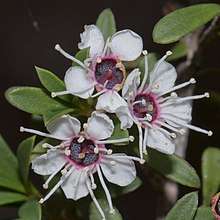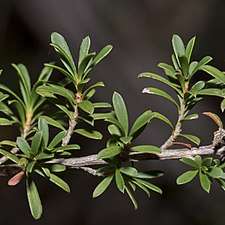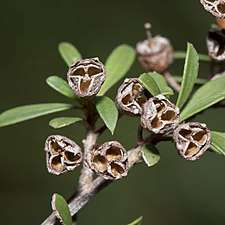Kunzea ericoides
| Kānuka | |
|---|---|
 | |
| Kunzea ericoides flowers on a plant growing near the White Rock River | |
| Scientific classification | |
| Kingdom: | Plantae |
| (unranked): | Angiosperms |
| (unranked): | Eudicots |
| (unranked): | Rosids |
| Order: | Myrtales |
| Family: | Myrtaceae |
| Genus: | Kunzea |
| Species: | K. ericoides |
| Binomial name | |
| Kunzea ericoides (A.Rich.) Joy Thomps. | |
| Synonyms[1] | |
|
| |
Kunzea ericoides, commonly known as kānuka, white tea-tree or burgan, is a tree or shrub in the myrtle family, Myrtaceae and is native to eastern Australia and New Zealand. It has white or pink flowers similar to those of Leptospermum and from its first formal description in 1832 until 1983 was known as Leptospermum ericoides. The flowers have five petals and up to 25 stamens which are mostly longer than the petals.
Description
Kunzea ericoides is a spreading shrub or tree, sometimes growing to a height of 18 m (60 ft) with bark which peels in long strips and young branches which tend to droop. The leaves are variable in shape from linear to narrow elliptic or lance-shaped, 6.5–25 mm (0.3–1 in) long and 1–5 mm (0.04–0.2 in) wide with a petiole up to 1 mm (0.04 in) long. The flowers are white or pale pink, crowded on side branches or in the axils of upper leaves. The floral cup is covered with soft, downy hairs and is on a pedicel 3–6 mm (0.1–0.2 in) long. There are five triangular sepals about 1 mm (0.04 in) long and five petals about 2 mm (0.08 in) long. There are up to 25 stamens which are 1–4 mm (0.04–0.2 in), mostly longer than the petals. Flowering occurs between October and February and is followed by fruit which is a cup-shaped capsule 2–4 mm (0.08–0.2 in) long and wide. The capsule usually opens to release its seed when mature.[2][3]
Taxonomy and naming
Kānuka was first formally described in 1832 by the French botanist Achille Richard who gave it the name Leptospermum ericoides from a specimen he collected in New Zealand. The description was published in Voyage de découvertes de l'Astrolabe - Botanique.[4][5] In 1983, Joy Thompson changed the name to Kunzea ericoides, describing the differences between Leptospermum and Kunzea in Telopea.[6][7] The specific epithet (ericoides) refers to the similarity of the habit of this species to that of Erica arborea.[8] The suffix -oides is a Latin ending meaning "likeness".[9]
Distribution and ecology
Kānuka (or mānuka, as it was mostly known until the 1930s) occurs in Australia and New Zealand. In Australia it occurs naturally in South Australia, Victoria, New South Wales and Queensland. In Tasmania it is regarded as an invasive species, sometimes mistaken for the native Kunzea ambigua or the similar Leptospermum scoparium.[10] As currently treated in New Zealand kānuka is a recognised species complex with the type species (and variety) only known from the north of the South Island.
Members of the kānuka complex are found throughout New Zealand occurring on the Three Kings Islands, Aotea (Great Barrier Island), from Te Paki (on the Aupouri Peninsula) at the northern tip of the North Island to as far south as Dunedin and Central Otago in the South Island, and Stewart Island. Within this range kānuka is widespread ranging from coastal scrub and sand dunes (where it may form a distinct forest type) through lowland and montane forest, with one member of the complex reaching elevations of 2000 metres above sea level. Kānuka often colonizes land recovering after a fire and is a critical part of the natural recovery of open disturbed ground to forest. With its small but abundant flowers it can colour a whole hillside white, almost giving the appearance of snow cover. It is widespread particularly in coastal scrub and colonizing land recovering after a fire or reverting to a natural state after being used for agriculture. It has also been recorded growing to altitudes of 2000 metres above sea level. The wood is very hard and although not durable in the ground it is used for wharf piles and tool handles. It is particularly popular as firewood, and burns with a great heat.
In New Zealand, kānuka can grow to around 10 metres high. Kākāriki parakeets (Cyanoramphus) use the leaves and bark of kānuka and the related mānuka tea trees to rid themselves of parasites. Apart from ingesting the material, they also chew it, mix it with preen gland oil and apply it to their feathers.[11] Mānuka and kānuka are superficially similar species and are often confused with one another. The easiest way to tell the difference between them is to feel the foliage, kānuka leaves being soft, while mānuka leaves are prickly.[12] K. ericoides may occur in the understory of certain rimu/nothofagus forests in the South Island. Typical associate understory species may include Crown Fern, Blechnum discolor and Cyathodes fasciculata.[13]
Prostrate kānuka
A variety of kānuka, the prostrate kānuka (Kunzea ericoides var. microflora), is one of the few plants that can survive hot ground in the immediate surroundings of geothermal features such as fumaroles and craters, for instance at "Craters of the Moon" (Karapiti), a geothermal area close to Taupo, New Zealand.[14]
Gallery
 Kunzea ericoides leaves
Kunzea ericoides leaves Kunzea ericoides opened fruit
Kunzea ericoides opened fruit
References
- ↑ "Kunzea ericoides". World Checklist of Selected Plant Families (WCSP). Royal Botanic Gardens, Kew.
- ↑ Wilson, Peter G. "Kunzea ericoides". Royal Botanic Gardens Sydney; plantnet. Retrieved 7 July 2017.
- ↑ de Lange, Peter J. "Kunzea ericoides". New Zealand Plant Conservation Network. Retrieved 7 July 2017.
- ↑ "Leptospermum ericoides". APNI. Retrieved 7 July 2017.
- ↑ Richard, Achille (1832). Voyage de découvertes de l'Astrolabe. Botanique. Paris: Henri Dupuy. pp. 338–339. Retrieved 7 July 2017.
- ↑ "Kunzea ericoides". APNI. Retrieved 7 July 2017.
- ↑ Thompson, Joy (1983). "Redefinitions and nomenclatural changes within WITHIN the Leptospermum suballiance of Myrtaceae". Telopea. 2 (4): 379–380.
- ↑ "Kunzea ericoides (A.Rich.) Joy Thomps.". Landcare Research: Manaaki Whenua. Retrieved 7 July 2017.
- ↑ Brown, Roland Wilbur (1956). The Composition of Scientific Words. Washington, D.C.: Smithsonian Institution Press. p. 45.
- ↑ "Kunzea ericoides". Mount Roland Rivercare Catchment Inc. Retrieved 7 July 2017.
- ↑ Terry Greene. 1989. Antiparasitic behaviour in New Zealand parakeets ("Cyanoramphus" species). Notornis (journal)| 36(4): 322–323. PDF fulltext
- ↑ John Dawson and Rob Lucas. 2000
- ↑ Hogan, C. Michael. "Crown Fern Blechnum discolor". Globaltwitcher.com. Retrieved 7 July 2017.
- ↑ Given, David R. (1980). "Vegetation on heated soils at Karapiti, central North Island, New Zealand, and its relation to ground". New Zealand Journal of Botany. 18: 1–13. Retrieved 7 July 2017.
- John Dawson and Rob Lucas. 2000. Nature guide to the New Zealand forest, Godwit Publishing
External links
-
 Media related to Kunzea ericoides at Wikimedia Commons
Media related to Kunzea ericoides at Wikimedia Commons -
 Data related to Kunzea ericoides at Wikispecies
Data related to Kunzea ericoides at Wikispecies
